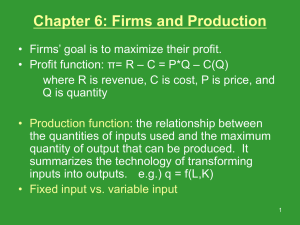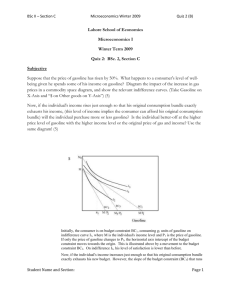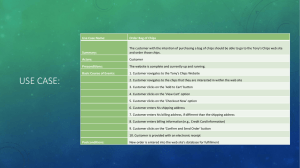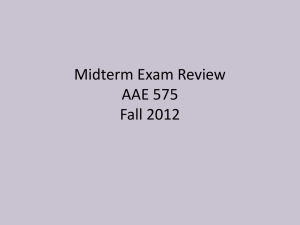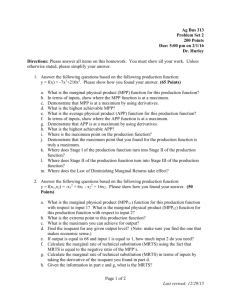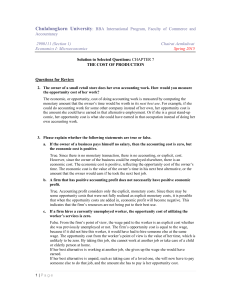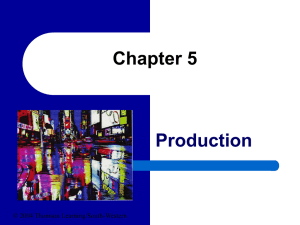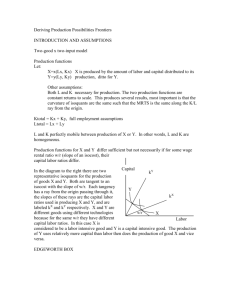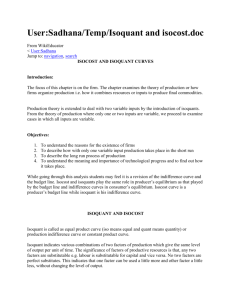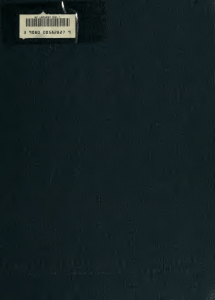Review Session #1 - Michigan State University
advertisement
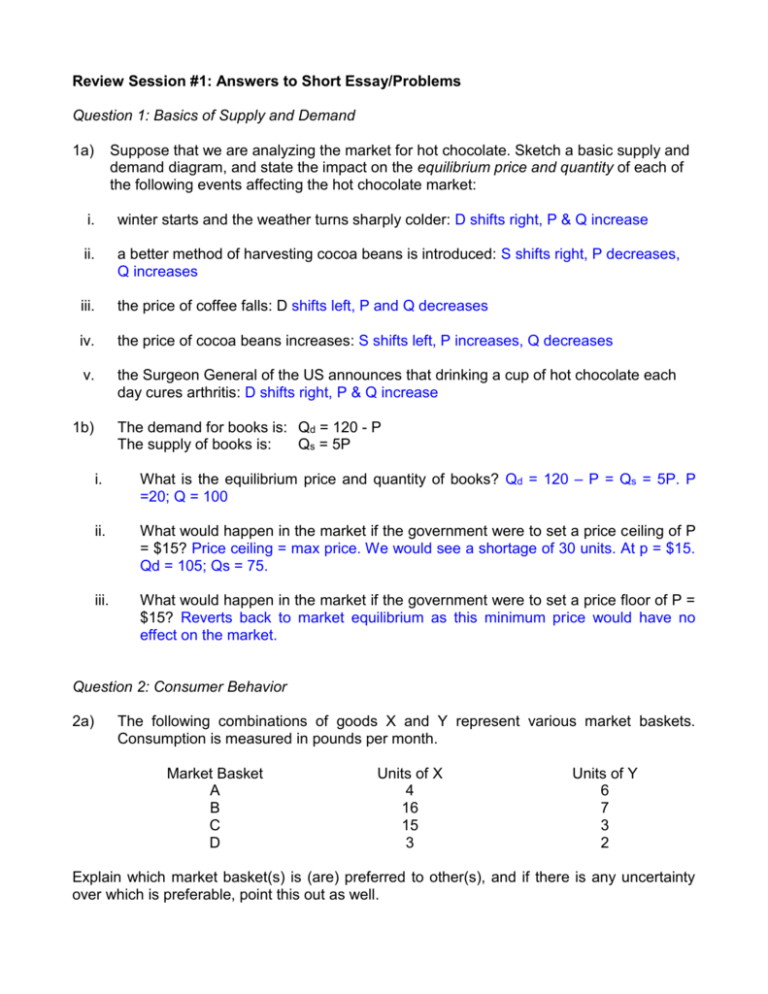
Review Session #1: Answers to Short Essay/Problems Question 1: Basics of Supply and Demand 1a) Suppose that we are analyzing the market for hot chocolate. Sketch a basic supply and demand diagram, and state the impact on the equilibrium price and quantity of each of the following events affecting the hot chocolate market: i. winter starts and the weather turns sharply colder: D shifts right, P & Q increase ii. a better method of harvesting cocoa beans is introduced: S shifts right, P decreases, Q increases iii. the price of coffee falls: D shifts left, P and Q decreases iv. the price of cocoa beans increases: S shifts left, P increases, Q decreases v. the Surgeon General of the US announces that drinking a cup of hot chocolate each day cures arthritis: D shifts right, P & Q increase 1b) The demand for books is: Qd = 120 - P The supply of books is: Qs = 5P i. What is the equilibrium price and quantity of books? Qd = 120 – P = Qs = 5P. P =20; Q = 100 ii. What would happen in the market if the government were to set a price ceiling of P = $15? Price ceiling = max price. We would see a shortage of 30 units. At p = $15. Qd = 105; Qs = 75. iii. What would happen in the market if the government were to set a price floor of P = $15? Reverts back to market equilibrium as this minimum price would have no effect on the market. Question 2: Consumer Behavior 2a) The following combinations of goods X and Y represent various market baskets. Consumption is measured in pounds per month. Market Basket A B C D Units of X 4 16 15 3 Units of Y 6 7 3 2 Explain which market basket(s) is (are) preferred to other(s), and if there is any uncertainty over which is preferable, point this out as well. Since more of each good is preferred to less, by assumption some comparisons can be made. B is preferred to all others because more X and Y would be consumed in B than in any other combination. A and C cannot be compared without additional information; however, A and C are both preferred over D because they make available more of X and Y than does D. 2b) Jane lives in a dormitory that offers soft drinks and chips for sale in vending machines. Her utility function is U = 3SC (where S is the number of soft drinks per week and C the number of bags of chips per week), so her marginal utility of S if 3C and her marginal utility of C is 3S. Soft drinks are priced at $0.50 each, chips $0.25 per bag. i. ii. Write an expression for Jane’s marginal rate of substitution between soft drinks and chips. MRS MU s MU c MRS 3C C 3S S Use the expression generated in part (a) to determine Jane’s optimal mix of soft drinks and chips. The optimal market basket is where MRS Ps Pc This requires = C S C .5 S .25 = 2, C = 2S which tells us Jane should buy twice as many chips as soft drinks. iii. If Jane has $5.00 per week to spend on chips and soft drinks, how many of each should she purchase per week? Well, I = PsS + PcC, and recall the optimal mix is C = 2S Thus, 5.00 = 0.5S + 0.25C. If C = 2S, this implies that 5.00 = 0.5S + (0.25)2S S = 5; C = 10 2c) Draw a set of indifference curves for the following pairs of goods: a. Hamburgers and carrots for a vegetarian who neither likes nor dislikes meat. (vegetarians do not eat meat): H = vertical; C = horizontal: ICs are straight lines (increasing utility to the right) b. Peanut butter and jelly for an individual that will not eat peanut butter sandwiches or jelly sandwiches, but loves peanut butter and jelly sandwiches made with two parts peanut butter and one part jelly: L-shaped ICs (2 to 1; 4 to 2, etc.) c. Tickets for Knott’s Berry Farm (KBF) and Universal Studios (US) for a tourist that believes that KBF and US are perfect substitutes: ICs are straight lines d. Ice cream and pie if these are goods that you like, but if you consume enough of either, you get sick of them: Normal ICs: diminishing marginal rate of substitution Question 3: Individual and Market Demand 3a) Suppose demand is given by Q = 100 – 4P. Graph this demand curve, and determine the quantity demanded when the price = $10. What is the level of consumer surplus when the price = $10, and how does this change if the price is raised to $20? When Q = 0, P =25; when P = 0, Q = 100. When P = $10, Qd = 60. CS = ½(60)(15) = $450. If P = $20, Qd = 20, and CS = ½(5)(20)=$50. 3b) Suppose you are the manager of a theater, and you currently charge the same admission price to everyone, regardless of their age. An economist calculates the price elasticity of demand, and tells you that at the current price, demand by adults is inelastic and demand by children is elastic. If you want to increase your total revenue, how should you adjust the admission price? Increase price to adults; reduce price to children. Total revenue will increase. 3c) The president of Michigan State University is concerned about increasing operating costs, and decides to raise tuition fees in an attempt to increase total revenue. Do you think the rise in tuition fees will accomplish the president's goal? Depends on the elasticity of demand: need to talk about the availability of substitutes. 3d) Suppose the Daily Newspaper estimates that if it raises the price of its newspaper from $1.00 to $1.50, its subscribers will fall from 50,000 to 40,000. Using the arc method, what is the price elasticity of demand for the Daily Newspaper? What does this tell us about consumer responsiveness? Ed = (40 – 50)/45 divided by (1.50 – 1)/1.25 = -0.222/0.4 = -0.556 3e) Briefly explain the substitution effect and the income effect when the price decreases for a normal good. Sub effect: as price decreases, Qd increases as increase consumption (sub away from other goods). Income effect: as price decreases, Qd increases if good is normal (increase in real purchasing power) Question 4: Production 4a) What is a production function? How does a long-run production function differ from a short-run production function? A production function represents how inputs are transformed into outputs. Given the technology, the firm maximizes output using a combination of inputs (K, L, raw materials). I.e. it shows what is technically feasible when the firm operates efficiently. In the short-run, can only vary L (capital is fixed). But in the long-run, all inputs are variable. 4b) Explain what an isoquant is. How does the slope of an isoquant relate to the marginal rate of technical substitution? An isoquant shows all possible combinations of inputs that yield the same level of output. The slope of the isoquant measures the rate at which two input can be exchanged and still keep output constant, and this rate is called the MRTS. Along the typical isoquant, the MRTS diminishes as you move down the isoquant. 4c) Complete the following table: Quantity of Variable Input 0 1 2 3 4 5 6 4d) Total Output 0 100 190 270 330 360 380 Marginal Product of Variable Input ----100 90 80 60 30 20 Average Product of Variable Input ----100 95 90 82.5 72 63.3 You manage a department in a large corporation. Two years ago, you had 20 workers and produced 40,000 units. The company allocated 10 more workers to your department, and output increased to 45,000. You just received a memo from your boss indicating that he is very concerned about the department. Explain why and how might you defend yourself? APL = 40,000/20 = 2,000. As hire more workers, APL = 45,000/30, and MPL = 5,000/10 = 500. Thus, MPL < APL, so if you continue to hire more workers, this will pull down the APL further. As a defense, I would argue that this is a short-run phenomenon. My department was allocated more workers, but not more capital, so the law of diminishing marginal returns holds. In all likelihood, the decline in average product is due to technical matters, and not management problems. Perhaps the K/L ratio should be increased?

